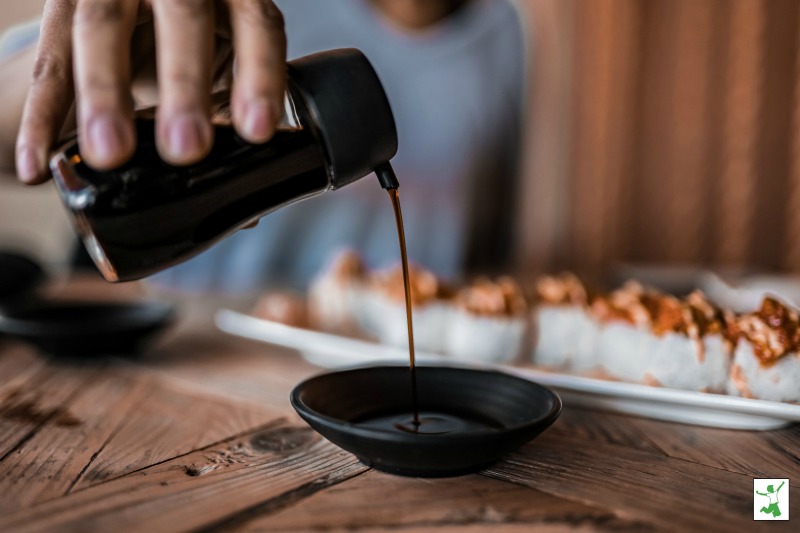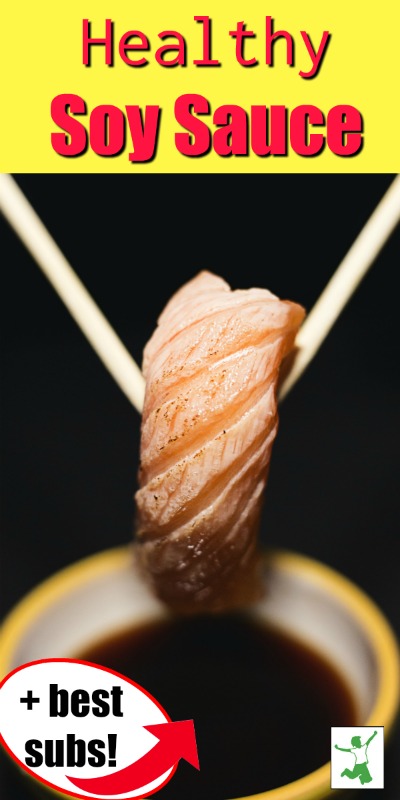What to look for when sourcing healthy soy sauce to obtain all the health benefits from the traditional brewing process and which substitutes are best to use if you are allergic to soy or avoiding grains.

Soy sauce, also commonly known as shoyu, is the best-known flavor enhancer in Asian cooking. Made the old-fashioned way — through a careful fermentation process that can take as long as 18 months — it’s a healthy and nourishing product.
The best quality, truly healthy brands of soy sauce are not only fermented in a traditional manner but also unpasteurized to retain beneficial enzymes and nutritional cofactors.
Tamari is a variant that is made only with soybeans (without any wheat). As far as I know, all the brands of tamari and most brands of shoyu sold in health food stores have been pasteurized. Though not optimal, these are far superior to the commercial soy sauces sold in supermarkets and used by the restaurant industry.
The Scary Truth About Commercial Soy Sauce
The most common soy sauces sold in supermarkets and served at the majority of restaurants are made in two days or less. Here’s how they do it.
If you really love your takeaway, you might want to sit down for this.
Soybean meal and often corn starches are rapidly reduced to their component amino acids using a high-tech process known as “rapid hydrolysis” or “acid hydrolysis”. This involves heating defatted hydrolyzed soy protein with eighteen percent hydrochloric acid for 8 to 12 hours, then neutralizing the brew with sodium carbonate. The result is a dark brown liquid — a chemical soy sauce.
When mixed with some genuine fermented soy sauce to improve its flavor and odor, it is called a “semi-chemical” soy sauce. Sugars, caramel colorings, and other flavorings are added before further refinement, pasteurization, and bottling.
The rapid hydrolysis method uses the enzyme glutamase as a reactor. This creates large amounts of an unnatural form of glutamic acid that closely resembles that found in MSG. In contrast, the production of genuine old-fashioned soy sauce uses the enzyme glutaminase to form naturally occurring glutamic acid.
Other undesirables that appear during chemical hydrolysis are levulinic and formic acids, instead of beneficial lactic acid, and the gas produces dimethyl sulfide, hydrogen sulfide and furfurol from the amino acid methionine. The hydrolysis process also results in the total destruction of the beneficial and essential amino acid tryptophan.
Modern soy sauces may also contain dangerous levels of chemicals known as chloropropanols, which are produced when soy sauce production is sped up using acid hydrolyzation methods. In Great Britain, back in 2001, nearly 25 percent of commercial soy sauces were found to contain dangerous levels of these chemicals, and the products were recalled.
The Australia New Zealand Food Authority also recalled commercial soy sauces for this reason. No recalls occurred in the United States, but because most modern companies use some form of this method and exercise less-than-perfect quality control, the safety of commercial soy sauces cannot be assured.
Researchers have also found furanone in commercial soy sauce. These are mutagenic to bacteria and cause DNA damage in lab tests. Salsolinol, a neurotoxin linked to DNA damage and chromosomal aberrations, Parkinson’s disease, and cancer, has been identified in soy sauce.
Ethyl carbamate — also linked to cancer– is found in commercial samples of soy sauce, light and dark miso and some alcoholic beverages. The maximum concentrations observed were 73 mcg per kg in soy sauce compared to the tiny amount of 7.9 mcg per kg found in miso.
Don’t Use Commercial Soy Sauce if on MAOI Drugs
Soy sauce also contains a high content of the amino acid tyramine, a potent precursor of mutagens produced by nitrites. The tyramine content makes this product unsuitable for people taking monoamine oxidase inhibitors (MAOI) drugs, which are commonly prescribed for depression, migraines, and high blood pressure.
The best-known tyramine rich foods are aged cheeses, red wines, smoked and pickled herring, and beer. Eating any of these foods — including tyramine rich soy sauce — while taking MAOI drugs can bring on an episode of high blood pressure accompanied by severe headache, palpitations, and nausea.
Healthy Soy Sauce
So for truly healthy soy sauce, get the genuine old fashioned fermented raw stuff.
Less optimal but still fine for most people are small amounts of health food store brand, pasteurized tamari, and shoyu.
Best (and worst) Soy Sauce Substitutes
Are you allergic to soy that is fermented or do you avoid grains in general?
Then, the best alternative to soy sauce is coconut aminos. This product is available either fermented or unfermented.
If sensitive to histamines or glutamate, choose unfermented coconut aminos (source).
Avoid Liquid Aminos
Think a liquid aminos soy sauce substitute would be healthier?
Think again!
Liquid aminos are an unfermented liquid soy product invented by health food pioneer Paul Bragg and is a soy sauce alternative preferred by many health aficionados. Its main claim to fame has been a lower sodium content than tamari or shoyu. Given that salt has been unjustly maligned as unhealthy, this may not even be desirable.
In any case, lower-sodium does not mean low, and the company responsible for manufacturing liquid aminos was warned in 1996 by the FDA that it’s “no salt” label was misleading and it’s “healthy” claim was unwarranted given its high sodium levels.
The company was also told to cease and desist using its “No MSG” claim. As a hydrolyzed protein, liquid aminos contain plenty of MSG produced as a residue of the hydrolyzing process. It also contains aspartic acid, another brain-damaging excitotoxin, which is a component of aspartame as well.
The takeaway: No bragging rights for liquid aminos!

More Information
Soy Lecithin: Really So Unhealthy?
Estrogenic Foods Like Soy Trigger Precancerous Breasts
Is Your Egg Allergy Really a Soy Allergy in Disguise?
170 Scientific Reasons to Eliminate Soy from Your Diet
Soy Formula is Harmful to a Child’s Development








Michele, have you tried coconut aminos? It’s a great soy sauce substitute!
I make a substitute because of my migraines. This is on my blog ~ http://lori1971.blogspot.com/2013/01/soy-sauce-substitute.html
Lori, thank you for your recipe. Looks ‘clean’, no soy product. Plus, I think we need to be careful with Japanese products – after the Fukushima radiation. (I think the brand that they recommended is made in Japan?). Check out this article: http://rawforbeauty.com/blog/holy-fukushima-radiation-from-japan-is-already-killing-north-americans.html
I’ve been using liquid aminos in my cooking, for about a year now, instead of soy sauce. We all love it!
Me too Brittany! I am so mad now! I am highly allergic to MSG and ALWAYs get severe headaches with it! Not to mention, my husband has a large kidney stone and we are being so careful about any salty products! The “bragging” is going to stop here! Thanks for this article!!!
I can’t figure out if Eden Foods’ version is unpasteurized or not. They didn’t respond back to me when I asked them, either. http://www.edenfoods.com/store/product_info.php?products_id=107310
What about organic Tamari?
due to soy allergies in the family, I *need* a soy sauce substitute. thanks !
Do you know if alcohol is a naturally occurring byproduct of the fermentation or if it is necessary added ingredient for tamari and soy sauce? I buy the san j organic tamari since its going to be heated in cooking anyway, but have only been able to find the cheap store brands without alcohol added.
Thanks for another very informative and important article.
Are there any raw, wheat free tamari products that you are aware of?
I am not aware of any unpasteurized tamari brands. Only the unpasteurized soy sauce linked in the article.
As an alternative, you might try Red Boat fermented fish sauce. It’s just anchovies and sea salt, traditionally fermented in wooden barrels. It gives a salty flavor boost to foods and if you put some on after the food has cooled a bit, you can preserve the fermented goodness and enzymes. It’s wheat free, soy free, everything free except for anchovies and sea salt, and is GAPS friendly to boot. (Note that some of the other brands, like Thai Kitchen fish sauce, are not fermented and contain sugar.)
Thanks for that info, Beth. 🙂
Thank you, Beth! I had no idea that Thai Kitchen fish sauce was not fermented! I’ll be throwing that bottle out and looking for one that is fermented! Is Red Boat the only one or are there others?
I purchased a raw, wheat free tamari from South River Miso a few years ago, made from their garlic red pepper miso. It’s a great company, who produces traditional, fermented products. I love every product I’ve ordered from them. They only ship in cooler months, so I don’t think you can order until September, but it’s worth the wait!
http://www.southrivermiso.com/
What about coconut aminos? Are those also not good?
Coconut aminos should be ok if the nectar is just aged. If the coconut nectar is hydrolyzed, that is not good. Perhaps check with the company of the brand you buy to double check about the specific processing technique they utilize.
Has anyone looked into the Coconut Secret brand?